A Critical Analysis of the Film Agora and Hypatia's Legacy
VerifiedAdded on 2023/06/04
|6
|1462
|86
Essay
AI Summary
This essay provides an analysis of the film Agora, which is set in Alexandria during the late 4th century CE and focuses on the life and contributions of Hypatia, a female philosopher, mathematician, and astronomer. The essay explores the historical context of the film, including the religious and political changes within the Roman Empire and the rise of Christianity. It highlights Hypatia's contributions to mathematics, such as her work on conic sections and her understanding of the heliocentric theory. The analysis also examines the film's portrayal of the clash between science and religion, and the controversies surrounding Hypatia's death. Furthermore, the essay discusses the film's portrayal of Hypatia's teaching methods, particularly the Socratic method, and its lasting impact on the development of various subjects. The essay references supporting sources, including Doherty, Fortin, Gray, Killings and Sharpe, to provide a well-rounded understanding of the subject matter.
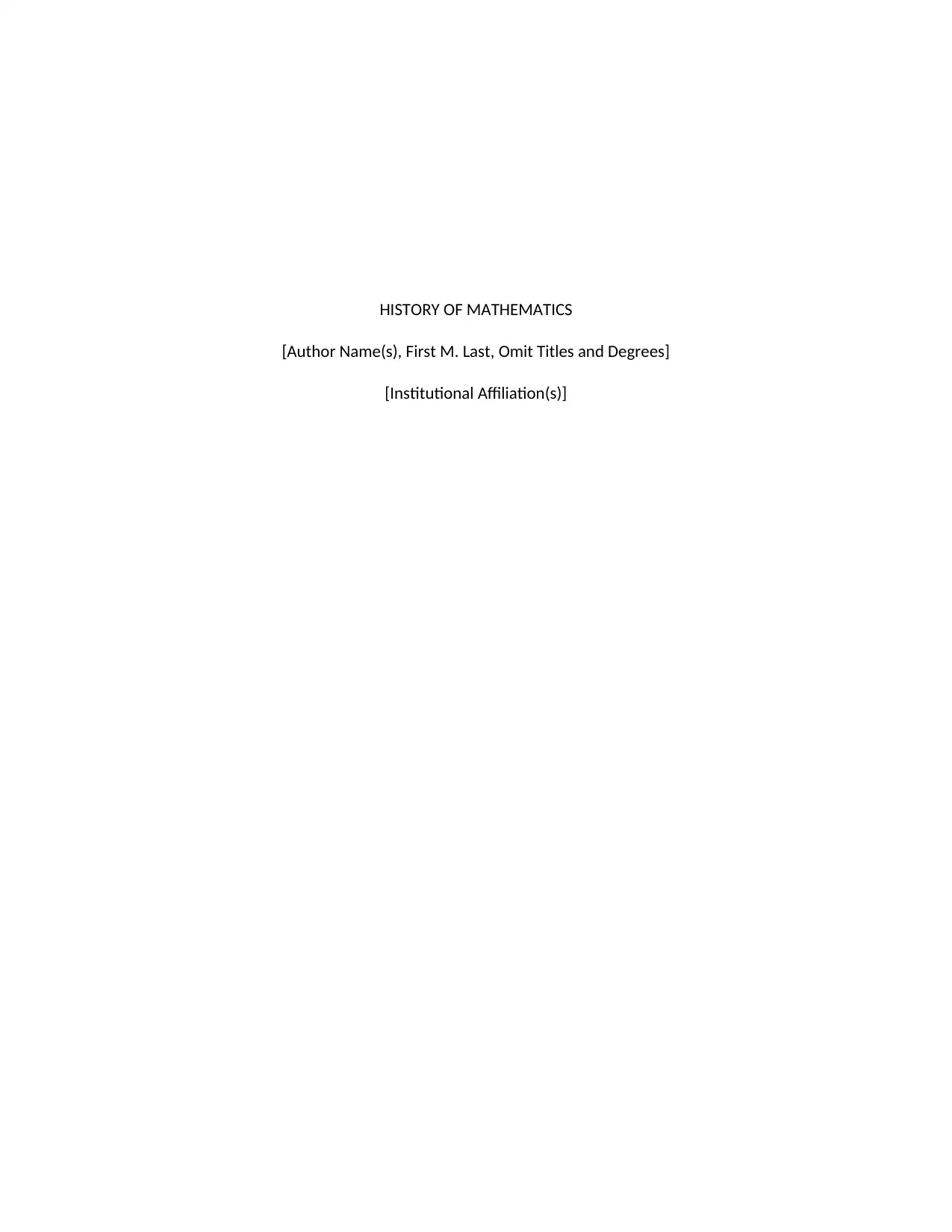
HISTORY OF MATHEMATICS
[Author Name(s), First M. Last, Omit Titles and Degrees]
[Institutional Affiliation(s)]
[Author Name(s), First M. Last, Omit Titles and Degrees]
[Institutional Affiliation(s)]
Paraphrase This Document
Need a fresh take? Get an instant paraphrase of this document with our AI Paraphraser
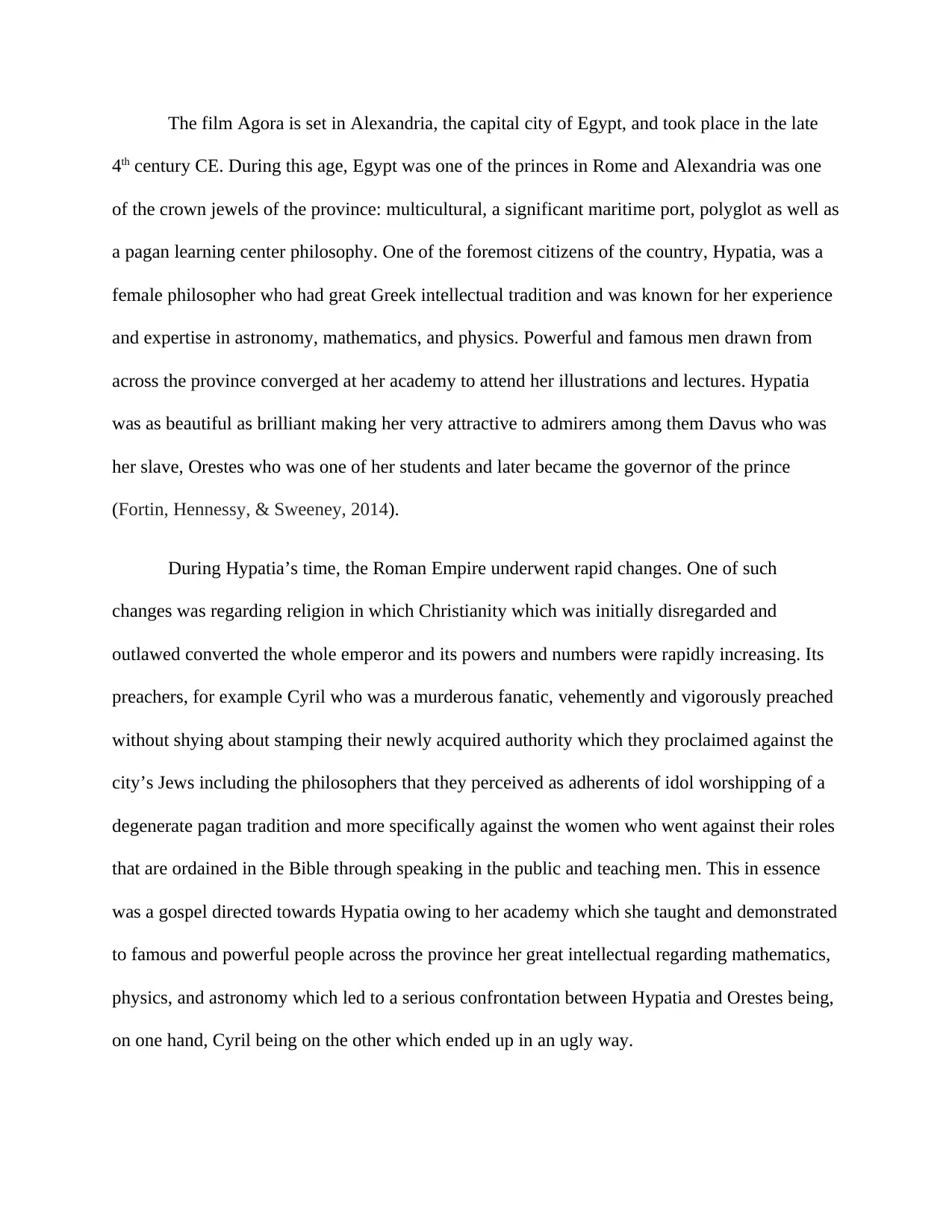
The film Agora is set in Alexandria, the capital city of Egypt, and took place in the late
4th century CE. During this age, Egypt was one of the princes in Rome and Alexandria was one
of the crown jewels of the province: multicultural, a significant maritime port, polyglot as well as
a pagan learning center philosophy. One of the foremost citizens of the country, Hypatia, was a
female philosopher who had great Greek intellectual tradition and was known for her experience
and expertise in astronomy, mathematics, and physics. Powerful and famous men drawn from
across the province converged at her academy to attend her illustrations and lectures. Hypatia
was as beautiful as brilliant making her very attractive to admirers among them Davus who was
her slave, Orestes who was one of her students and later became the governor of the prince
(Fortin, Hennessy, & Sweeney, 2014).
During Hypatia’s time, the Roman Empire underwent rapid changes. One of such
changes was regarding religion in which Christianity which was initially disregarded and
outlawed converted the whole emperor and its powers and numbers were rapidly increasing. Its
preachers, for example Cyril who was a murderous fanatic, vehemently and vigorously preached
without shying about stamping their newly acquired authority which they proclaimed against the
city’s Jews including the philosophers that they perceived as adherents of idol worshipping of a
degenerate pagan tradition and more specifically against the women who went against their roles
that are ordained in the Bible through speaking in the public and teaching men. This in essence
was a gospel directed towards Hypatia owing to her academy which she taught and demonstrated
to famous and powerful people across the province her great intellectual regarding mathematics,
physics, and astronomy which led to a serious confrontation between Hypatia and Orestes being,
on one hand, Cyril being on the other which ended up in an ugly way.
4th century CE. During this age, Egypt was one of the princes in Rome and Alexandria was one
of the crown jewels of the province: multicultural, a significant maritime port, polyglot as well as
a pagan learning center philosophy. One of the foremost citizens of the country, Hypatia, was a
female philosopher who had great Greek intellectual tradition and was known for her experience
and expertise in astronomy, mathematics, and physics. Powerful and famous men drawn from
across the province converged at her academy to attend her illustrations and lectures. Hypatia
was as beautiful as brilliant making her very attractive to admirers among them Davus who was
her slave, Orestes who was one of her students and later became the governor of the prince
(Fortin, Hennessy, & Sweeney, 2014).
During Hypatia’s time, the Roman Empire underwent rapid changes. One of such
changes was regarding religion in which Christianity which was initially disregarded and
outlawed converted the whole emperor and its powers and numbers were rapidly increasing. Its
preachers, for example Cyril who was a murderous fanatic, vehemently and vigorously preached
without shying about stamping their newly acquired authority which they proclaimed against the
city’s Jews including the philosophers that they perceived as adherents of idol worshipping of a
degenerate pagan tradition and more specifically against the women who went against their roles
that are ordained in the Bible through speaking in the public and teaching men. This in essence
was a gospel directed towards Hypatia owing to her academy which she taught and demonstrated
to famous and powerful people across the province her great intellectual regarding mathematics,
physics, and astronomy which led to a serious confrontation between Hypatia and Orestes being,
on one hand, Cyril being on the other which ended up in an ugly way.
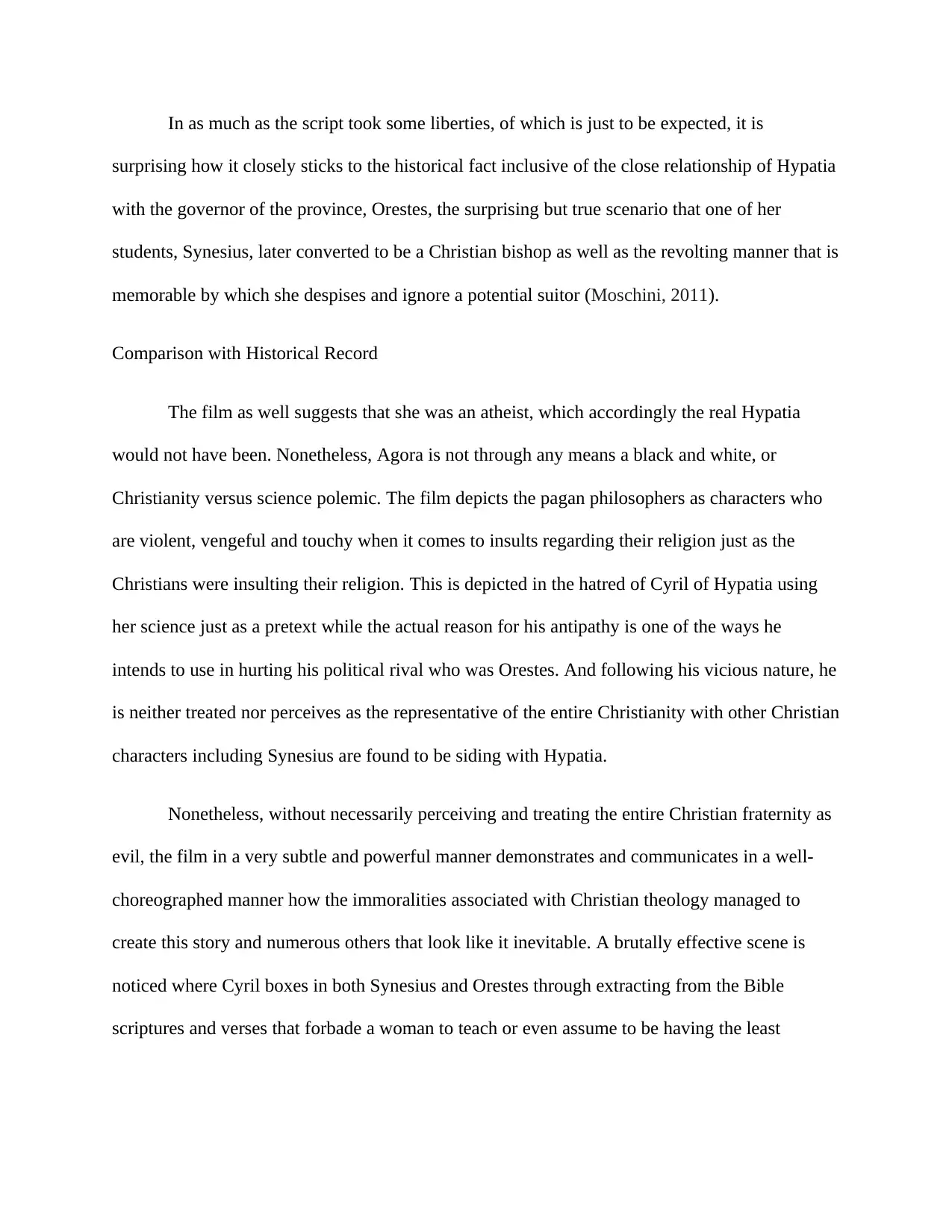
In as much as the script took some liberties, of which is just to be expected, it is
surprising how it closely sticks to the historical fact inclusive of the close relationship of Hypatia
with the governor of the province, Orestes, the surprising but true scenario that one of her
students, Synesius, later converted to be a Christian bishop as well as the revolting manner that is
memorable by which she despises and ignore a potential suitor (Moschini, 2011).
Comparison with Historical Record
The film as well suggests that she was an atheist, which accordingly the real Hypatia
would not have been. Nonetheless, Agora is not through any means a black and white, or
Christianity versus science polemic. The film depicts the pagan philosophers as characters who
are violent, vengeful and touchy when it comes to insults regarding their religion just as the
Christians were insulting their religion. This is depicted in the hatred of Cyril of Hypatia using
her science just as a pretext while the actual reason for his antipathy is one of the ways he
intends to use in hurting his political rival who was Orestes. And following his vicious nature, he
is neither treated nor perceives as the representative of the entire Christianity with other Christian
characters including Synesius are found to be siding with Hypatia.
Nonetheless, without necessarily perceiving and treating the entire Christian fraternity as
evil, the film in a very subtle and powerful manner demonstrates and communicates in a well-
choreographed manner how the immoralities associated with Christian theology managed to
create this story and numerous others that look like it inevitable. A brutally effective scene is
noticed where Cyril boxes in both Synesius and Orestes through extracting from the Bible
scriptures and verses that forbade a woman to teach or even assume to be having the least
surprising how it closely sticks to the historical fact inclusive of the close relationship of Hypatia
with the governor of the province, Orestes, the surprising but true scenario that one of her
students, Synesius, later converted to be a Christian bishop as well as the revolting manner that is
memorable by which she despises and ignore a potential suitor (Moschini, 2011).
Comparison with Historical Record
The film as well suggests that she was an atheist, which accordingly the real Hypatia
would not have been. Nonetheless, Agora is not through any means a black and white, or
Christianity versus science polemic. The film depicts the pagan philosophers as characters who
are violent, vengeful and touchy when it comes to insults regarding their religion just as the
Christians were insulting their religion. This is depicted in the hatred of Cyril of Hypatia using
her science just as a pretext while the actual reason for his antipathy is one of the ways he
intends to use in hurting his political rival who was Orestes. And following his vicious nature, he
is neither treated nor perceives as the representative of the entire Christianity with other Christian
characters including Synesius are found to be siding with Hypatia.
Nonetheless, without necessarily perceiving and treating the entire Christian fraternity as
evil, the film in a very subtle and powerful manner demonstrates and communicates in a well-
choreographed manner how the immoralities associated with Christian theology managed to
create this story and numerous others that look like it inevitable. A brutally effective scene is
noticed where Cyril boxes in both Synesius and Orestes through extracting from the Bible
scriptures and verses that forbade a woman to teach or even assume to be having the least
⊘ This is a preview!⊘
Do you want full access?
Subscribe today to unlock all pages.

Trusted by 1+ million students worldwide
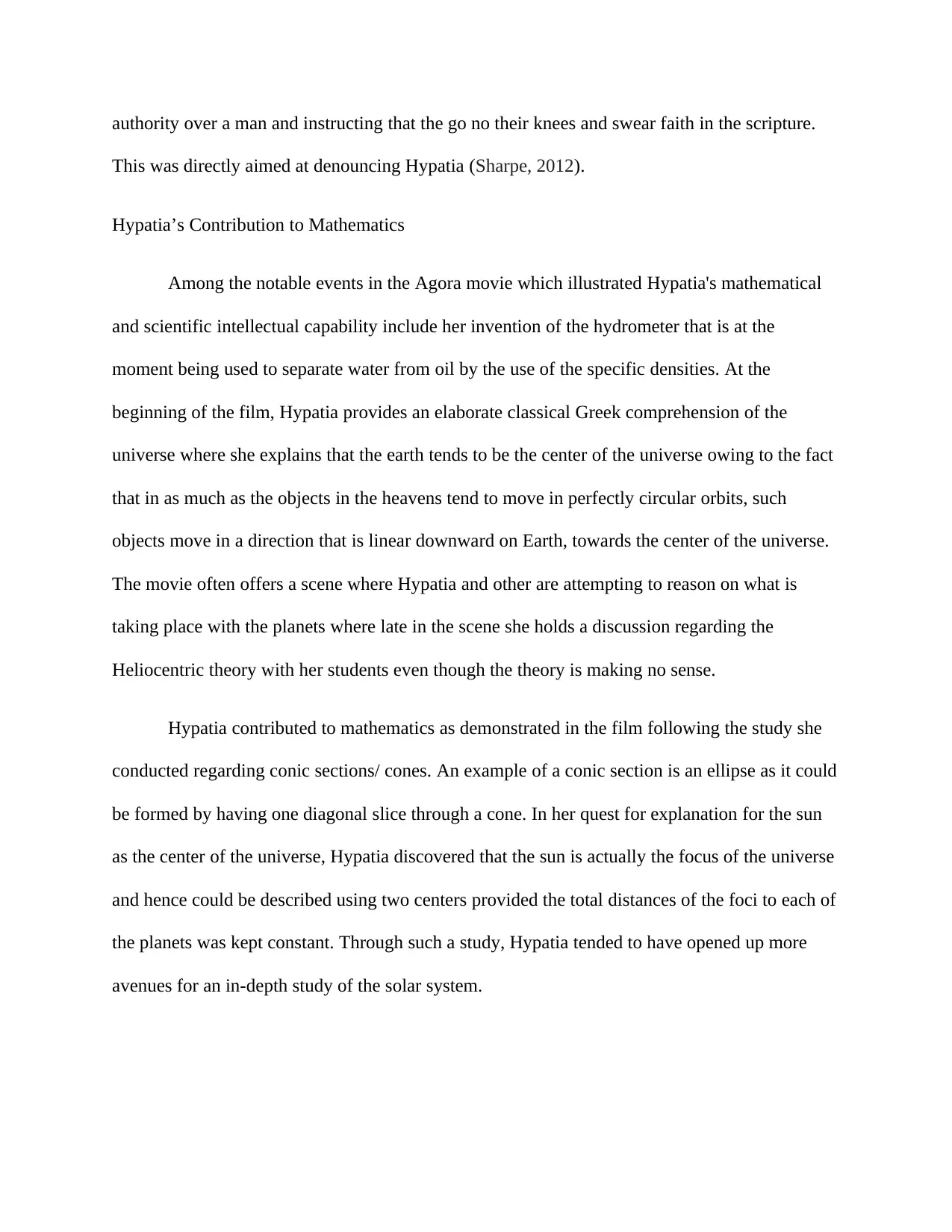
authority over a man and instructing that the go no their knees and swear faith in the scripture.
This was directly aimed at denouncing Hypatia (Sharpe, 2012).
Hypatia’s Contribution to Mathematics
Among the notable events in the Agora movie which illustrated Hypatia's mathematical
and scientific intellectual capability include her invention of the hydrometer that is at the
moment being used to separate water from oil by the use of the specific densities. At the
beginning of the film, Hypatia provides an elaborate classical Greek comprehension of the
universe where she explains that the earth tends to be the center of the universe owing to the fact
that in as much as the objects in the heavens tend to move in perfectly circular orbits, such
objects move in a direction that is linear downward on Earth, towards the center of the universe.
The movie often offers a scene where Hypatia and other are attempting to reason on what is
taking place with the planets where late in the scene she holds a discussion regarding the
Heliocentric theory with her students even though the theory is making no sense.
Hypatia contributed to mathematics as demonstrated in the film following the study she
conducted regarding conic sections/ cones. An example of a conic section is an ellipse as it could
be formed by having one diagonal slice through a cone. In her quest for explanation for the sun
as the center of the universe, Hypatia discovered that the sun is actually the focus of the universe
and hence could be described using two centers provided the total distances of the foci to each of
the planets was kept constant. Through such a study, Hypatia tended to have opened up more
avenues for an in-depth study of the solar system.
This was directly aimed at denouncing Hypatia (Sharpe, 2012).
Hypatia’s Contribution to Mathematics
Among the notable events in the Agora movie which illustrated Hypatia's mathematical
and scientific intellectual capability include her invention of the hydrometer that is at the
moment being used to separate water from oil by the use of the specific densities. At the
beginning of the film, Hypatia provides an elaborate classical Greek comprehension of the
universe where she explains that the earth tends to be the center of the universe owing to the fact
that in as much as the objects in the heavens tend to move in perfectly circular orbits, such
objects move in a direction that is linear downward on Earth, towards the center of the universe.
The movie often offers a scene where Hypatia and other are attempting to reason on what is
taking place with the planets where late in the scene she holds a discussion regarding the
Heliocentric theory with her students even though the theory is making no sense.
Hypatia contributed to mathematics as demonstrated in the film following the study she
conducted regarding conic sections/ cones. An example of a conic section is an ellipse as it could
be formed by having one diagonal slice through a cone. In her quest for explanation for the sun
as the center of the universe, Hypatia discovered that the sun is actually the focus of the universe
and hence could be described using two centers provided the total distances of the foci to each of
the planets was kept constant. Through such a study, Hypatia tended to have opened up more
avenues for an in-depth study of the solar system.
Paraphrase This Document
Need a fresh take? Get an instant paraphrase of this document with our AI Paraphraser
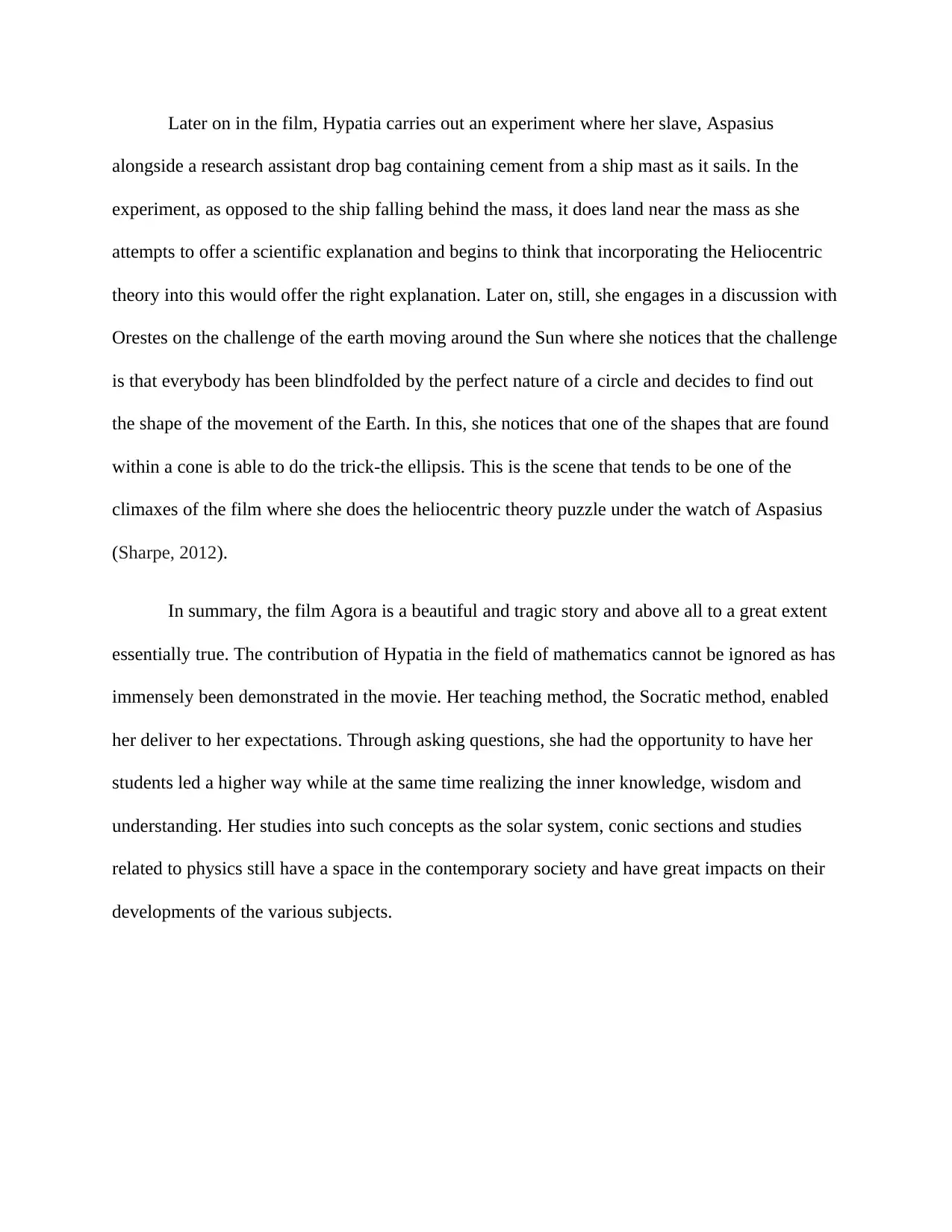
Later on in the film, Hypatia carries out an experiment where her slave, Aspasius
alongside a research assistant drop bag containing cement from a ship mast as it sails. In the
experiment, as opposed to the ship falling behind the mass, it does land near the mass as she
attempts to offer a scientific explanation and begins to think that incorporating the Heliocentric
theory into this would offer the right explanation. Later on, still, she engages in a discussion with
Orestes on the challenge of the earth moving around the Sun where she notices that the challenge
is that everybody has been blindfolded by the perfect nature of a circle and decides to find out
the shape of the movement of the Earth. In this, she notices that one of the shapes that are found
within a cone is able to do the trick-the ellipsis. This is the scene that tends to be one of the
climaxes of the film where she does the heliocentric theory puzzle under the watch of Aspasius
(Sharpe, 2012).
In summary, the film Agora is a beautiful and tragic story and above all to a great extent
essentially true. The contribution of Hypatia in the field of mathematics cannot be ignored as has
immensely been demonstrated in the movie. Her teaching method, the Socratic method, enabled
her deliver to her expectations. Through asking questions, she had the opportunity to have her
students led a higher way while at the same time realizing the inner knowledge, wisdom and
understanding. Her studies into such concepts as the solar system, conic sections and studies
related to physics still have a space in the contemporary society and have great impacts on their
developments of the various subjects.
alongside a research assistant drop bag containing cement from a ship mast as it sails. In the
experiment, as opposed to the ship falling behind the mass, it does land near the mass as she
attempts to offer a scientific explanation and begins to think that incorporating the Heliocentric
theory into this would offer the right explanation. Later on, still, she engages in a discussion with
Orestes on the challenge of the earth moving around the Sun where she notices that the challenge
is that everybody has been blindfolded by the perfect nature of a circle and decides to find out
the shape of the movement of the Earth. In this, she notices that one of the shapes that are found
within a cone is able to do the trick-the ellipsis. This is the scene that tends to be one of the
climaxes of the film where she does the heliocentric theory puzzle under the watch of Aspasius
(Sharpe, 2012).
In summary, the film Agora is a beautiful and tragic story and above all to a great extent
essentially true. The contribution of Hypatia in the field of mathematics cannot be ignored as has
immensely been demonstrated in the movie. Her teaching method, the Socratic method, enabled
her deliver to her expectations. Through asking questions, she had the opportunity to have her
students led a higher way while at the same time realizing the inner knowledge, wisdom and
understanding. Her studies into such concepts as the solar system, conic sections and studies
related to physics still have a space in the contemporary society and have great impacts on their
developments of the various subjects.
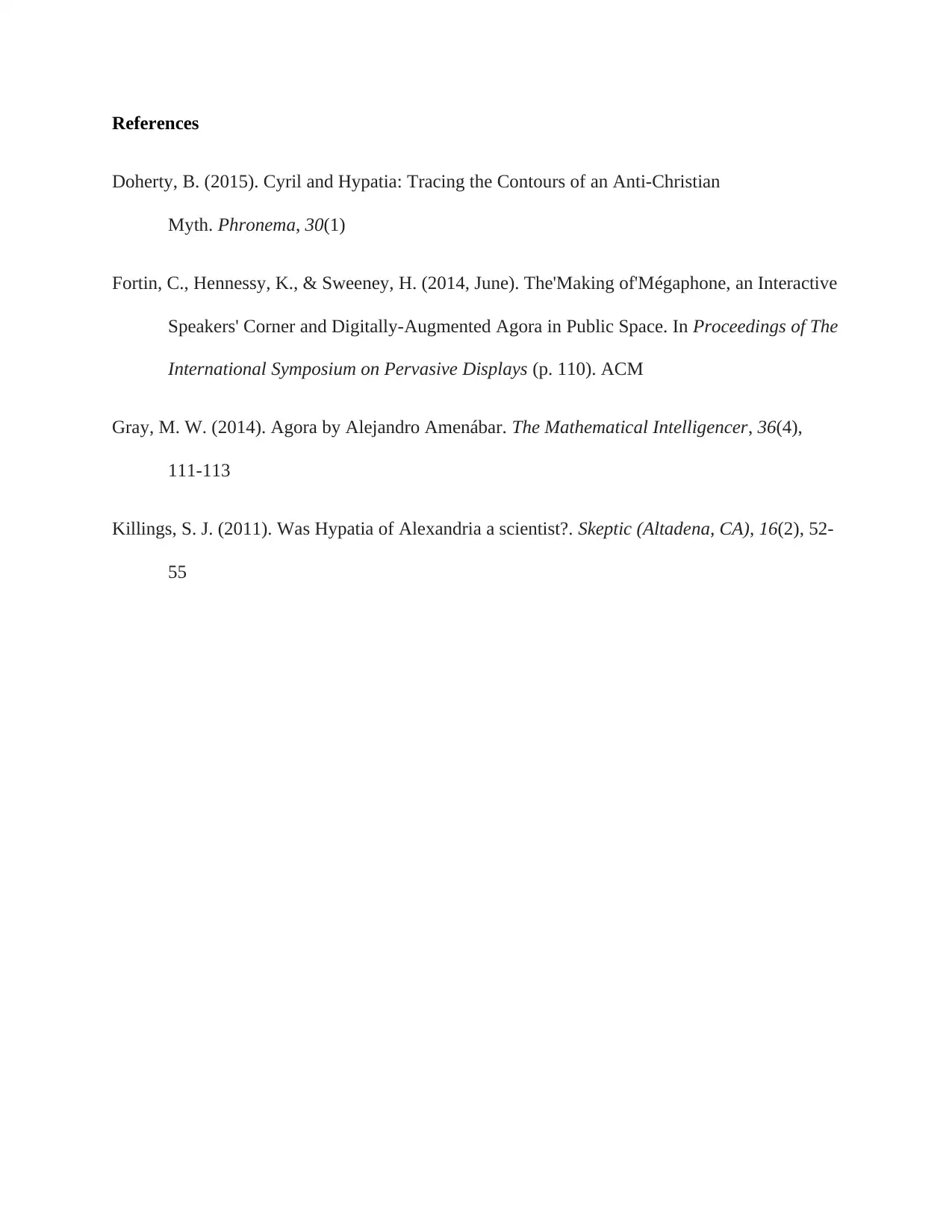
References
Doherty, B. (2015). Cyril and Hypatia: Tracing the Contours of an Anti-Christian
Myth. Phronema, 30(1)
Fortin, C., Hennessy, K., & Sweeney, H. (2014, June). The'Making of'Mégaphone, an Interactive
Speakers' Corner and Digitally-Augmented Agora in Public Space. In Proceedings of The
International Symposium on Pervasive Displays (p. 110). ACM
Gray, M. W. (2014). Agora by Alejandro Amenábar. The Mathematical Intelligencer, 36(4),
111-113
Killings, S. J. (2011). Was Hypatia of Alexandria a scientist?. Skeptic (Altadena, CA), 16(2), 52-
55
Doherty, B. (2015). Cyril and Hypatia: Tracing the Contours of an Anti-Christian
Myth. Phronema, 30(1)
Fortin, C., Hennessy, K., & Sweeney, H. (2014, June). The'Making of'Mégaphone, an Interactive
Speakers' Corner and Digitally-Augmented Agora in Public Space. In Proceedings of The
International Symposium on Pervasive Displays (p. 110). ACM
Gray, M. W. (2014). Agora by Alejandro Amenábar. The Mathematical Intelligencer, 36(4),
111-113
Killings, S. J. (2011). Was Hypatia of Alexandria a scientist?. Skeptic (Altadena, CA), 16(2), 52-
55
⊘ This is a preview!⊘
Do you want full access?
Subscribe today to unlock all pages.

Trusted by 1+ million students worldwide
1 out of 6
Your All-in-One AI-Powered Toolkit for Academic Success.
+13062052269
info@desklib.com
Available 24*7 on WhatsApp / Email
![[object Object]](/_next/static/media/star-bottom.7253800d.svg)
Unlock your academic potential
Copyright © 2020–2025 A2Z Services. All Rights Reserved. Developed and managed by ZUCOL.